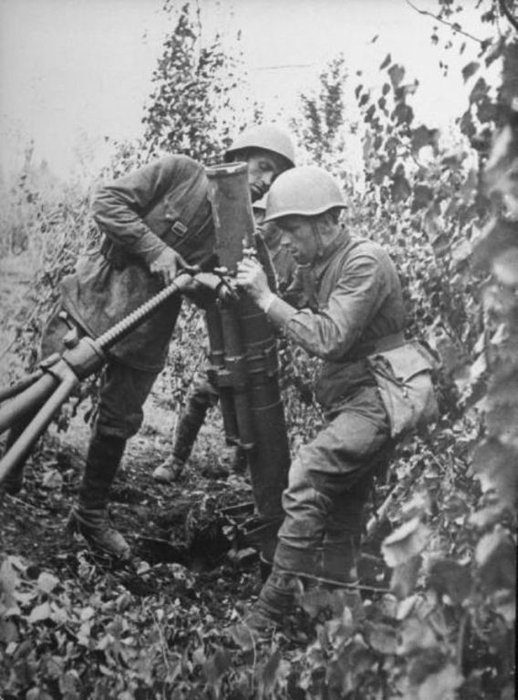


Mortier de 120mm Modèle 1939
English Translation
 |
Historique Voir ICI
History Click HERE
Autre Photoscopes Others Walk Around
Mortier de 120mm Modèle 1939
Mortier de 120mm Modèle 1939 Bucarest
Mortier de 120mm Modèle 1939
This weapon, 120-mm Soviet regimental mortar model 1938, was basically a scaled up version of 82-mm battalion mortar model 1937. Structurally the mortar was conventional Stokes-Brandt related design divided to base plate (weight some 94 kg), bipod (about 62 kg) and barrel (about 100 kg). It was transported on similar one-axle two-wheeled limber as 107 mm regimental mortar model 1938, but its the towing system included usually also one-axle two-wheeled ammunition cart, which contained 20 mortar shells. The Soviets had both normal and heavy high explosive shells for this mortar. The normal 16-kg mortar shell contained about 2.7-kg of explosive, while the heavy mortar shell weight 23.9-kg and contained 7.6-kg of explosive. What is known during Winter War the Soviets still didn't yet have their 120-mm mortars in large-scale production. At the time they also seem to have still been secret weapon, which the Soviets were only field-testing in battles of Winter War. It also seems that the Finns didn't notice existence of these new heavy Soviet mortars either. So when Germany attacked Soviet Union in summer of 1941 the Germans were still unaware about their existence. 120-HM 38 mortar soon proved to be highly successful design, indeed many might argue that it was one of the very best mortar designs of World War 2. The mortar shells it fired were powerful enough to do serious damage, it had a good maximum range, remarkable mobility and taking it in or out of action was both easy and quite fast to move from one place to another. In fact the captured mortars of this model impressed the Germans so much, that not only took the captured 120-HM 38 to their own use as 12 cm GrW 378(r). But they also reverse engineered it and starting manufacturing their own copies, which they named 12 cm GrW 42. During World War 2 the Soviets developed also new version of this mortar called 120-HM 43, which was otherwise similar to 120-HM 38, but it had only single shock absorber on the barrel-bipod mounting. By end of World War 2 estimated Soviet production of 120-mm mortars totalled over 12,000 mortars.
Barrel and breech of 120 Krh/38 weight about 100-kg. Base plate weight about 94-kg and bipod about 62-kg. The weapon had removable transport carriage and limber. During transport the mortar with its transport carriage weight about 490-kg. When also limber was included the weapon + transport carriage + limber with ammunition they reached total weight of 1,150-kg. The firing mechanism of this mortar had settings - one which fired it automatically when mortar shell was dropped to barrel and another setting which allowed firing each shot with trigger (attached to lanyard). Limber of this mortar could contain 20 mortar shells with propellant charges and fuses needed for them.
Finnish Army captured its first Soviet 120-cm mortars in year 1941 and named them 120 Krh/38 (120 mm mortar model 1938). The total number of these mortars captured during Continuation War was around 200. Practically all of them were HM 38, but there were also at least 17 mortars 120-HM 43 (120 Krh/38-42 for the Finnish Army) among the Soviet mortars captured in year 1944. Year 1943 Finland also bought from Germany 50 of these mortars. They arrived with S/S Norma 4th of April 1943. Since these 50 mortars were lacking limbers and mortar directors they could not be issued right away. During Continuation War Finnish industry was manufacturing improved limber (which allowed faster motorised towing) for these captured mortars. During Continuation War Finnish Army re-issued captured 120-mm in large numbers to combat troops, for example 1st of June 1944 Finnish Army inventory contained 187 of these mortars and 122 of them were issued to frontline troops. Since in addition to captured ammunition also Finnish 120-mm mortar ammunition could be used in these mortars there was no real danger of ammunition shortage. During Continuation War these mortars saw plenty of combat use with Finnish troops. They proved effective and well liked, but since the Finns had also their mortar design (120 Krh/40), year 1944 Ordnance Department of Finnish Armed Forces General Headquarters asked feedback concerning these two mortars from the troops.
When combined the feedback letters offer the following view:
"The base plate of 120 Krh/38 is bigger and has a better form - it stays well in its place and sinks less to the ground than base plate of 120 Krh/40. Firing mechanism not included the weapon is solid and accurate. However this mortar is clumsier and heavier to transport than 120 Krh/40. The firing mechanism is unnecessarily complicated and malfunctions much too easily. The bottom of barrel is too weak. Screws of the bipod are unprotected and the thread of elevation setting system too steep. The recoil system is simple, but after recoil it does not return always to exactly the same position. Conclusion: 120 Krh/40 is superior in all other areas, but 120 Krh/38 has a better base